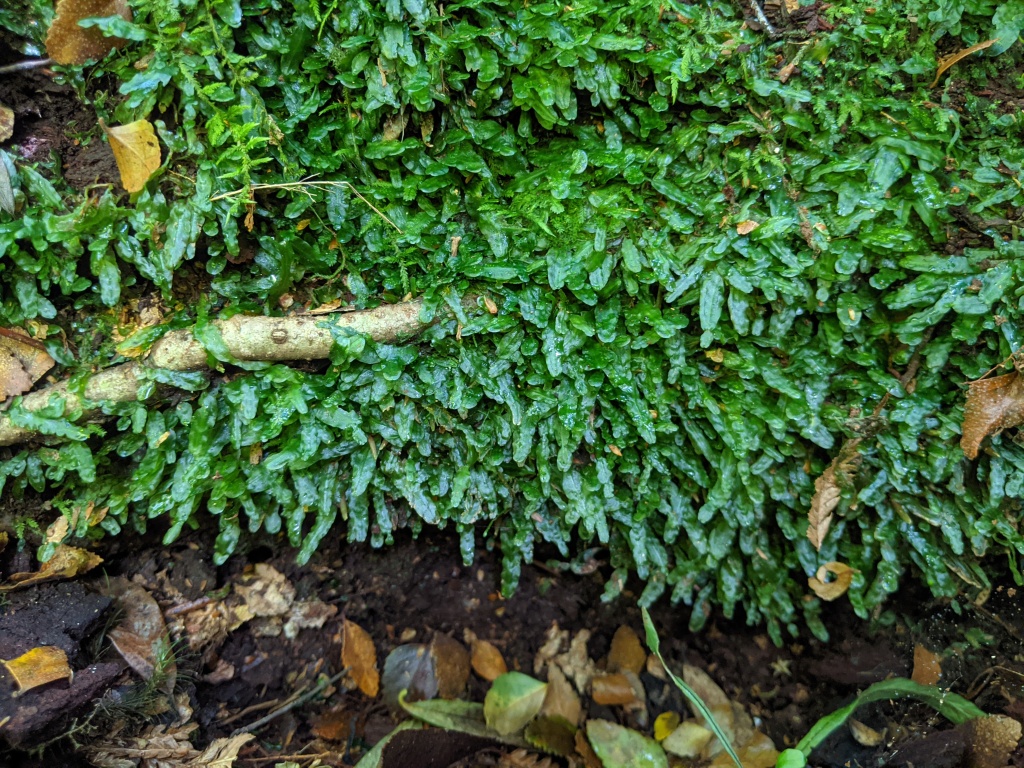Pallaviciniaceae
Terrestrial, sometimes epiphytic (not in Victoria), on logs or lithophytic (not in Victoria), dioicous, sometimes male plants smaller than female plants. Asexual reproduction rarely by ovoid gemmae scattered over thallus adaxial surface (not in Victoria). Plants comprising a simple to dichotomously forked thallus, sometimes with branches emerging from abaxial midrib, rarely incised to the midrib to form irregular leaf-like lobes (not in Victoria), with a basal much narrower stipe section often arising from a prostrate rhizome; thallus prostrate or erect, with a prominent midrib, multistratose toward midrib, unistratose near margins, without air chambers, without air pores, pale to dark green, yellow green, translucent green or sometimes reddish; thallus margins entire or toothed, plane or undulate; thallus cells polygonal, thin-walled, without distinct trigones, with up to 15 grey, granulate and spherical to fusiform oil bodies. Abaxial appendages slime papillae or slime hairs, scales absent. Rhizoids arising from stipes and rhizomes or at intervals from abaxial midrib of thallus, smooth, colourless, brown or reddish-brown. Antheridia adaxial on leading thallus in 1–several elongate rows along midrib or on either side of midrib of thallus, or in two rows adaxial on reduced ovate branch emerging from abaxial thallus midrib, superficial or partially sunken in thallus, usually covered by a well-developed scale, or rarely not associated with scales (not in Victoria) or associated with irregular lamellate outgrowths (not in Victoria). Sporophytes with an involucre and a shoot calyptra, sometimes also surrounded by a pseudoperianth, rarely subtended by a lamella extension of the thallus wings (not in Victoria), adaxial on leading thallus along midrib or restricted to point where midrib bifurcates, or at the apex of reduced branch emerging from abaxial stipe; shoot calyptra usually becoming prominent, cylindric to clavate and fleshy, thin and concealed if pseudoperianth present; pseudoperianth tubular, with toothed or ciliate mouth; involucre a laciniate to fimbriate ring, sometimes dissected into scales, a single entire (not in Victoria) to irregularly dissected scale, or cup-shaped and not deeply dissected (not in Victoria). Seta elongate. Capsule ellipsoid to cylindric, bi- to multistratose (not in Victoria), dehiscing by 2 or 4 valves, remaining connate at apex; elaters present, bispiral or rarely 3 or more spiralled (not in Victoria). Spores finely areolate or granulate, brown, shed singly.
Eight genera and 67 species occurring in the tropics and subtropics throughout the world and temperate and subantarctic regions of the Southern Hemisphere, but with one widespread species also scattered throughout northern temperate regions and one species extending to Japan (Söderström et al. 2016); three genera and six species in Victoria.
Söderström, L., Hagborg, A., von Konrat, M., Bartholomew-Began, S., Bell, D., Briscoe, L., Brown, E., Cargill, D.C., Costa, D.P., Crandall-Stotler, B.J., Cooper, E.D., Dauphin, G., Engel, J.J., Feldberg, K., Glenny, D., Gradstein, S.R., He, X., Heinrichs, J., Hentschel, J., Ilkiu-Borges, A.L., Katagiri, T., Konstantinova, N.A., Larraín, J., Long, D.G., Nebel, M., Pócs, T., Puche, F., Reiner-Drehwald, E., Renner, M.A.M., Sass-Gyarmati, A., Schäfer-Verwimp, A., Moragues, J.S., Stotler, R.E., Sukkharak, P., Thiers, B.M., Uribe, J., Váňa, J., Villarreal, J.C., Wigginton, M., Zhang, L. & Zhu, R. (2016). World checklist of hornworts and liverworts. Phytokeys 59: 1–828.
 Spinning
Spinning